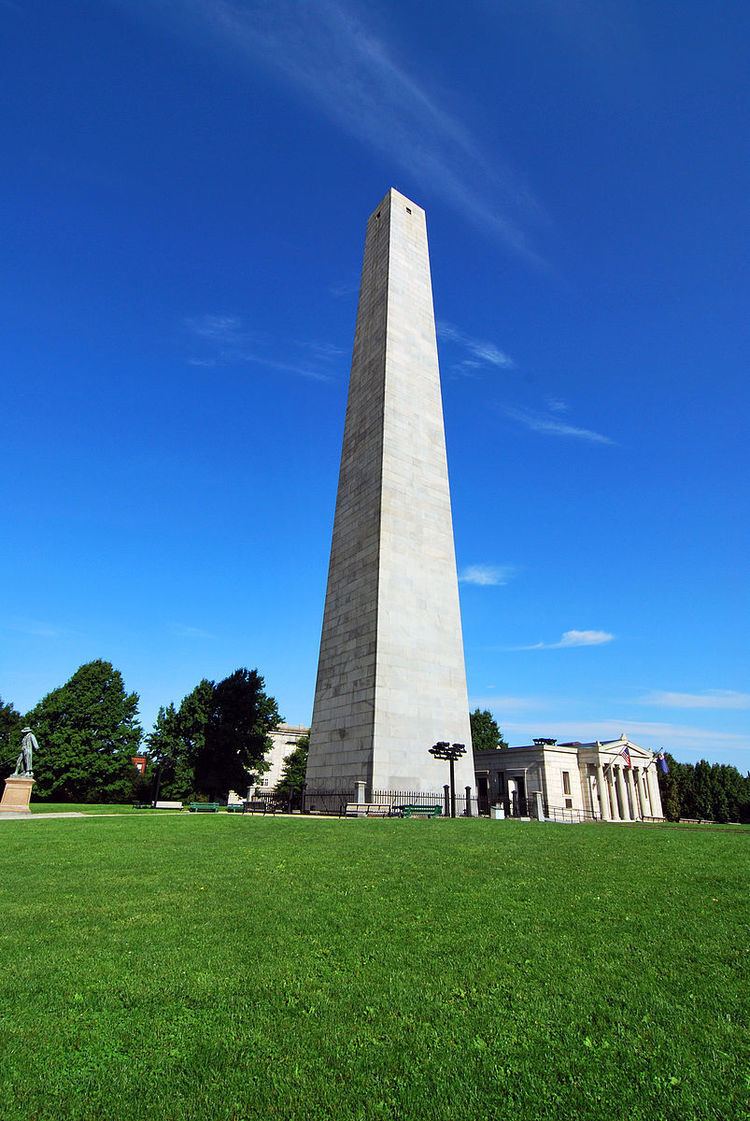Architectural style Obelisk Added to NRHP October 15, 1966 Area 2 ha | Built 1825-43 NRHP Reference # 66000138 Height 67 m | |
 | ||
Address Monument Sq, Charlestown, MA 02129, USA Hours Closed now Monday9AM–5PMTuesday9AM–5PMWednesday9AM–5PMThursday9AM–5PMFriday9AM–5PMSaturday9AM–5PMSunday9AM–5PM Similar Freedom Trail, Paul Revere House, Old North Church, Old State House, Granary Burying Ground | ||
Boston bunker hill monument tour
The Bunker Hill Monument was erected to commemorate the Battle of Bunker Hill, which was among the first major battles between British and Patriot forces in the American Revolutionary War, fought there June 17, 1775. The 221-foot (67 m) granite obelisk was erected between 1827 and 1843 in Charlestown, Massachusetts, with granite from nearby Quincy conveyed to the site via the purpose-built Granite Railway, followed by a trip by barge. There are 294 steps to the top.
Contents
- Boston bunker hill monument tour
- Bunker hill monument up stair top of tower
- Background
- Construction
- References
An exhibit lodge built adjacent to the monument in the late 19th century houses a statue of fallen hero Dr. Joseph Warren. Bunker Hill is one of the sites along the Freedom Trail and is part of Boston National Historical Park.
The monument underwent a $3.7 million renovation, completed in 2007, that included repairs, handicap accessibility improvements, and new lighting. The Bunker Hill Museum across the street was dedicated in June of that year and includes many exhibits about the battle. No admission charge applies to the museum or monument.
Bunker hill monument up stair top of tower
Background
The monument was one of the first in the United States. An earlier memorial at the site had been erected in memory of fallen Bunker Hill hero Dr. Joseph Warren, a Mason, in 1794 by King Solomon's Lodge of Masons, and was initially an 18-foot (5.5 m) wooden column topped with a gilt urn. In front of the obelisk is a statue of Col. William Prescott, a native of Groton, Massachusetts, another hero of Bunker Hill. According to popular stories, he coined the famous Revolutionary War phrase, "Don't fire until you see the whites of their eyes" during the battle. However, various writers attribute it to Putnam, Stark, Prescott or Gridley, while others question whether it was said at all.
The Monument is not on Bunker Hill, but instead on Breed's Hill, where most of the fighting in the misnamed Battle of Bunker Hill actually took place. The Monument Association, which had purchased the battlefield site, was forced to sell off all but the hill's summit in order to complete the monument.
Construction
William Ticknor, a well-known Boston lawyer and antiquarian, first suggested the memorial. An interested group of men met for breakfast at the home of Colonel Thomas Handasyd Perkins, including William Tudor, Daniel Webster, Professor George Ticknor, Doctor John C. Warren, William Sullivan, and George Blake. On May 10, 1823, the first public meeting was called. Each member subscribed five dollars, and on June 7, 1823, the Bunker Hill Monument Association was established and the work of raising money was begun. Famed nineteenth-century philanthropist Amos Lawrence contributed $10,000 to the monument's erection.
In the spring of 1825 the directors had purchased about 15 acres (61,000 m²) on the slope of Breed's Hill, but had not yet chosen a design. The first design committee consisted of Webster, noted engineer Loammi Baldwin, Jr., George Ticknor, Gilbert Stuart, and Washington Allston. One hundred dollars was offered for the best design; about 50 plans were presented in response. Choice was soon narrowed to a column and an obelisk and a new committee was appointed to procure designs and estimate expenses for each. At the next meeting the majority voted that the obelisk designed by Solomon Willard be used. The directors laid the cornerstone on June 17, 1825. The Marquis de Lafayette (who was on a 14-month tour of the United States on the 50th anniversary of the War) performed the ceremony, Webster delivered the oration, and the Grand Master of the Grand Lodge of Massachusetts, Ancient Free and Accepted Masons, conducted the services. Rev. Joseph Thaxter, who was wounded in the battle, officiated as chaplain at the ceremony, offering a prayer in thanks for the colonists' victory.
Blocks of granite for the monument averaged two cubic yards each and were quarried by wedging. Delivered to the site of the monument at an actual cost of $5.40 per cubic yard from a quarry opened for the purpose far under the average contract offers for the same of $24.30. Work proceeded somewhat slowly at first, but the Granite Railway was completed in short order and became operational on October 7, 1826, as the first commercial railroad in the United States functioning as a common carrier.
Construction was frequently halted as available funds were depleted. To bring the project to completion the Monument Association in 1838 began to sell off the 10 acres (40,000 m2) of the battlefield as house lots, eventually preserving only the summit of Breed's Hill as the monument grounds. Neighbors disgruntled with the construction eyesore were rumored to have plans to raise money to tear down the partially completed monument. Sarah Josepha Hale and the readers of her magazine supplied funds essential to the monument's successful completion. The capstone was laid on July 23, 1842 with the monument being dedicated on June 17 of the following year, again with a Daniel Webster oration.
The Bunker Hill Monument Association maintained the monument and grounds until 1919, when it was turned over to the Commonwealth of Massachusetts. In 1976 the monument was transferred to the National Park Service and became a unit of Boston National Historical Park. The monument was designated a National Historic Landmark in 1961, in part for its architectural significance as a major early war memorial, and the nation's largest-scale memorial prior to the construction of the Washington Monument. It was listed on the National Register of Historic Places in 1966, and was included in the Monument Square Historic District in 1987.
